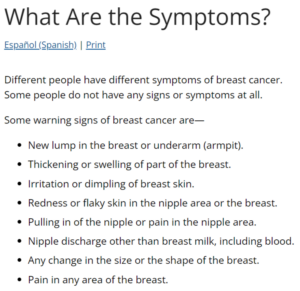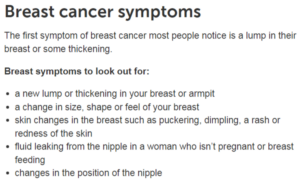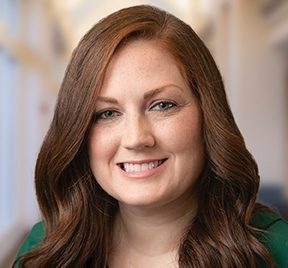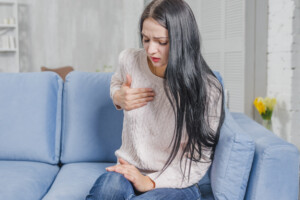Have you been experiencing pain in a breast, especially in the same spot, but don’t feel any new lump yet are worried you might have cancer?
It’s not impossible for breast cancer to cause pain.
However, it’s so uncommon, especially relative to the numerous benign causes of breast pain, that it would be illogical to lose sleep over a fear of cancer if you have unexplained pain or soreness in a breast – and no lump detected.
Metastatic breast cancer, though, often does cause pain, depending on where the malignant cells have spread.
For instance, metastases in the brain can cause headaches. If they’re in a bone, they can cause deep pain in that location.
But the chances of a localized breast cancer causing pain, soreness or tenderness in the affected breast is at the bottom of the list for possible causes of a new-onset of breast discomfort.
There is no data on what percentage of women, who have breast cancer, felt pain in a breast but no lump, or, for that matter, felt pain in a breast with a malignant lump.
If you put keywords into the search field for Google Scholar, which is an easy-to-navigate site where you can search for scholarly literature including that for medical, most of the results for “breast pain” will pertain to such caused by cancer treatment.
I plugged in several permutations of the keyphrasing, and found no results for reports on breast pain as a symptom of breast cancer.
“The data does not support any relationship between breast pain and early breast cancer,” says Jennifer Hartman, a clinical nurse practitioner specializing in breast health, women’s health and cancer genetics.
“On the contrary. most breast cancers present with a non-tender lump.
“Of course, any new lump — whether it is tender or not — warrants an exam and evaluation by your healthcare provider to confirm it’s not cancer and to offer medical care for the pain.
“The most common causes of breast pain include hormone changes, increased caffeine intake, poorly fitting bras or a breast injury.”
The severity of breast pain may not correlate to the intensity of the injury.
For example, I’ve been struck in the breast area while sparring in karate class, without anything more than small bruises the day after, that I didn’t even feel.
However, one day I experienced brief and sudden, but sharp shooting pains in my right outer breast.
These sensations came and went throughout the day for no apparent reason, and were occurring nearly daily.
It took a while, but I finally figured out the cause: My right upper arm would press against this breast’s outer area while my fingers massaged my left inner elbow to help relieve tendonitis there.
When I made a point to make sure my upper arm did not contact my breast, the sharp pains stopped and never returned.
There was another time I was having odd, transient pains (not too bad, but definitely noticeable) in my breasts, and eventually realized they were caused by a tight bra.
Breast Pain with Early Breast Cancer
Though there is no research into what percentage of patients have had the experience of pain caused by only a localized tumor, this does not mean that any breast cancer specialist can declare that it’s not possible for a malignant tumor in a breast to cause pain or tenderness in that location.
A lump causing pain or discomfort, however, is recognized as being a highly unlikely sign of breast cancer.
Nevertheless, the Centers for Disease Control include “pain in the nipple area” and “any pain in the breast” as possible symptoms for breast cancer, among many other (and much more likely) causes.
See the images below showing what two reputable sources name as possible symptoms for breast cancer.

Cdc.gov

cancerresearchuk.org
The Takeaway
• The likelihood of a confined malignant lump in a breast causing pain in that area is extremely low – so low that you’ll probably be unable to find any reports in medical journals giving data on incidence.
• If you have unexplained pain in a breast, ask yourself if anything new has been pressing against your breast lately, including another body part.
• Pain in the breast that does not resolve after two weeks should be examined by a doctor.
• Absence of breast pain does NOT mean you can’t have cancer.
• If you discover a lump and also have pain near the lump, this doesn’t mean that the lump is the cause.
• Any lump should be visualized with an imaging tool and NEVER simply given a “watch and wait” instruction.
 Jennifer Hartman, NP, specializes in surgical breast oncology and has 14+ years of nursing background involving (but not limited to) high-risk breast care, cancer genetics, breast cancer survivorship, gynecological care and homeless healthcare.
Jennifer Hartman, NP, specializes in surgical breast oncology and has 14+ years of nursing background involving (but not limited to) high-risk breast care, cancer genetics, breast cancer survivorship, gynecological care and homeless healthcare.
 Lorra Garrick has been covering medical, fitness and cybersecurity topics for many years, having written thousands of articles for print magazines and websites, including as a ghostwriter. She’s also a former ACE-certified personal trainer.
Lorra Garrick has been covering medical, fitness and cybersecurity topics for many years, having written thousands of articles for print magazines and websites, including as a ghostwriter. She’s also a former ACE-certified personal trainer.
.










































